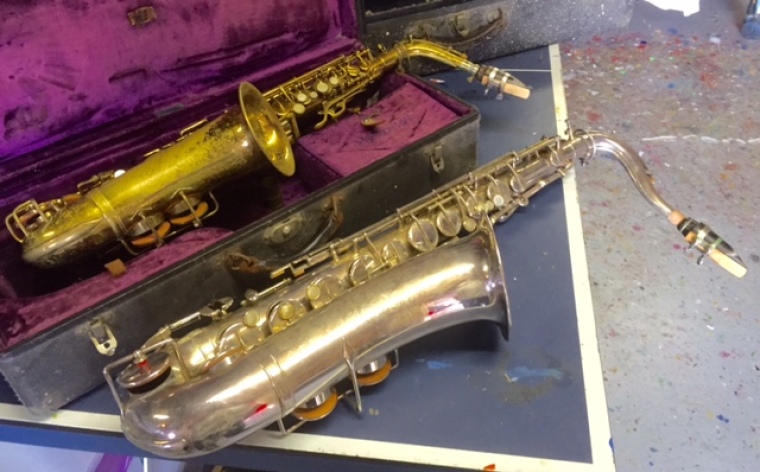
Wikipedia adequately describes the saxophone (also referred to simply as a "sax") for those with a technical bent. It is a member of the woodwind family with a single-reed mouthpiece similar to that of the clarinet and is usually made of brass.
The saxophone was invented by Adolphe Sax in 1841. He wanted to create an instrument that would both be the most powerful and vocal of the woodwinds and the most adaptive of the brass, which would fill the then vacant middle ground between the two sections. He patented the sax in 1846 in two groups of seven differently-sized instruments each. One series was pitched suitably for military bands and another in concert pitch suitable for orchestras.
Although the concert instruments never quite 'took off', there is some repertoire of classical orchestral music. However, it is the E-flat/B-flat series that has proved the most popular in its intended niche of military bands, becoming even more common over the years in popular music, jazz of all types (including big band and blues), early rock and ska.
http://en.wikipedia.org/wiki/Saxophone
Mark Tronson's initial passion for the saxophone was at high school where he attended a Baptist Youth for Christ rally held at the Telopea Park High School auditorium and the guest (Alto) Saxophonist played the theme music of the movie, 'Those magnificent men in their Flying Machines'.
He can remember even now how the idea tugged at his soul, that he would very much love to learn to play the saxophone. His parents were not in a position to purchase one, so he had to wait until he started working as a trainee engineman and moved to Goulburn at the age of sixteen. Fortuitously, someone told him that the town band's retired saxophonist was selling his (alto) saxophone which Mark bought for $80 in 1968.
He took a couple of lessons, and bought the book "Learning to play the Saxophone"; but when he transferred to Port Kembla in 1969, Providence took him in hand. The organist, Mavis Wilson, had a son-in-law who was an accomplished saxophonist.
M V Tronson came to an arrangement: he would mow her lawns and she would give him a one hour piano-saxophone jam session so as to provide live practice; and they would do double-time just prior to concerts or rallies where he needed to play. This worked well for many years.
Eventually, he played well enough to join a Christian Youth Band in the early 1970s, taking the stage alongside a variety of other instrumentalists including a violinist, a clarinettist, a trumpeter, a drummer and a keyboard player. This was the time when the Pentecostal movement was first developing similar 'band' type music for their services.
Mrs Mavis Wilson became a very close family friend, and when he was courting Delma (now his wife of 33 years) who sometimes visited from northern NSW, she was welcomed to stay at Mrs Wilson's home.
In 1972 Mark Tronson spied an advertisement in the local Illawarra Mercury newspaper that a pre loved tenor Saxophone (silver-plated) was for sale but in poor condition. He purchased it for $140. The person who reconditioned it for him explained that it was of a type that had come out from America during WWII, probably left by an American solider who left it here expecting to collect it, but like many others, never returned to these shores.
Because the instruments available are usually in E flat (the alto sax) or B flat (the tenor sax), there is a difficulty in reading sheet music written for Christian gospel or hymns. These are usually written in the key of C (as is concert music). So, in order to play in tune with either a piano or organ, the saxophone player must transpose the notes to fit the instrument.
In effect, what this meant is that Mark Tronson, with the brilliant help of Mrs Wilson, learnt to play the alto Saxophone by reading C score music as if it were three notes higher, and the tenor Saxophone two notes lower. This could become tricky, particularly where the score had unusual notations for sharps and flats, which are half a note above or below (the usual note).
He said that Mrs Wilson often consulted her son-in-law Robert Heaton on this, particularly to help explain the theory about why some sharps and flats were more difficult to transpose correctly, so as to make the saxophone sound 'right' with the other instruments.
After 40 years, Mark Tronson still plays his saxophones occasionally. In former times, he remembers, he could play fluently. At a Morling Theological College 'Student Camp Retreat' in 1978 he arose at 6.00am and played on his alto sax, the famous hymn, "I hear Thy Welcome Voice". He remembers that they all slept in regardless.
His most recent foray was two years ago at Easter time when he played "Were you there when they crucified my Lord" on his tenor Saxophone for the Tweed Anglican Men's Fellowship Dinner. He recalls that although he had requested that everyone meditate on the well known words in silence, by the second verse everyone had joined in and were singing, ignoring his request entirely.
M V Tronson says that saxophones have beautiful tones and in his mind's eye, the sounds from this instrument lights up the spirits of those who have the ears to hear!